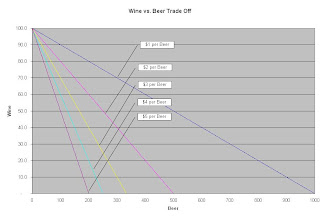The topic of today's post is simple, but very powerful: Budget Lines. For any given two items, that have a cost, one can buy any combination of the two items, as long as the cost of the combination is under the budget (or, available funds, if you will) for the two items. A budget line is the set of combinations where the cost of the combination is equal to the budget for the items.

An example will make this clearer: Suppose that a college student has $1,000 to spend on booze for the school year. The student likes to drink beer and wine. A bottle of beer costs $1 and a bottle of wine costs $10. So, for our student, he can buy 1,000 beers, 100 bottles of wine, 900 beers and 10 bottles of wine, or any combination where $1 * Beers + $10 * Bottles of Wine is less than or equal to $1,000. The $1 per bottle of beer line represents this equation in the illustration.
The line, and every point under the line, represents an available combination of beer and wine that the student can buy.
The other four lines represents what happens to the available combinations when the price of wine is held fixed, and the price of beer is increased to $2, $3, $4, and $5 per bottle. As expected the number of available combinations goes down as the price of beer goes up. The intuitive idea is that with a fixed budget, when the price of the input (beer) goes up, one can afford less.
This exercise can be done for any two items that have a cost and a budget associated with them: trips to Sydney and cat food, gas and milk, months of cable TV and movie rentals, etc, etc, etc. The idea of a budget line is simple; but it a tool that allows some powerful analysis in to peoples demand.
No comments:
Post a Comment